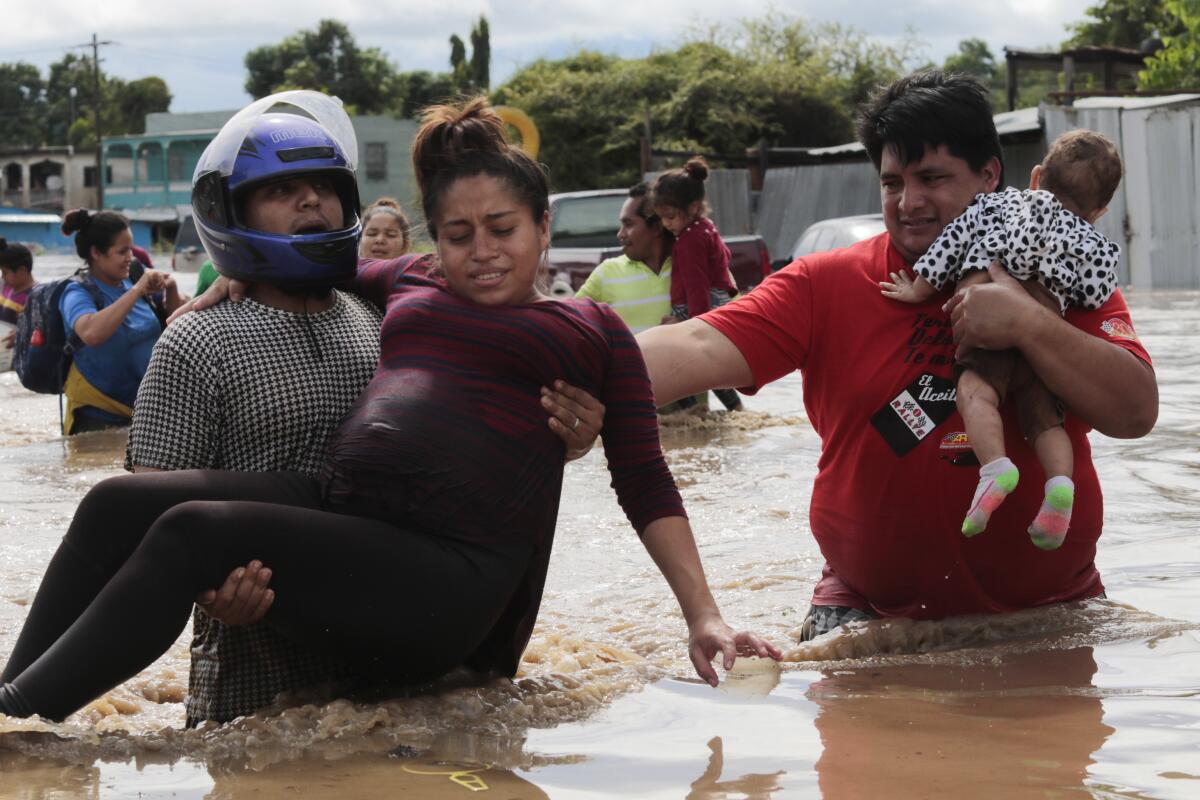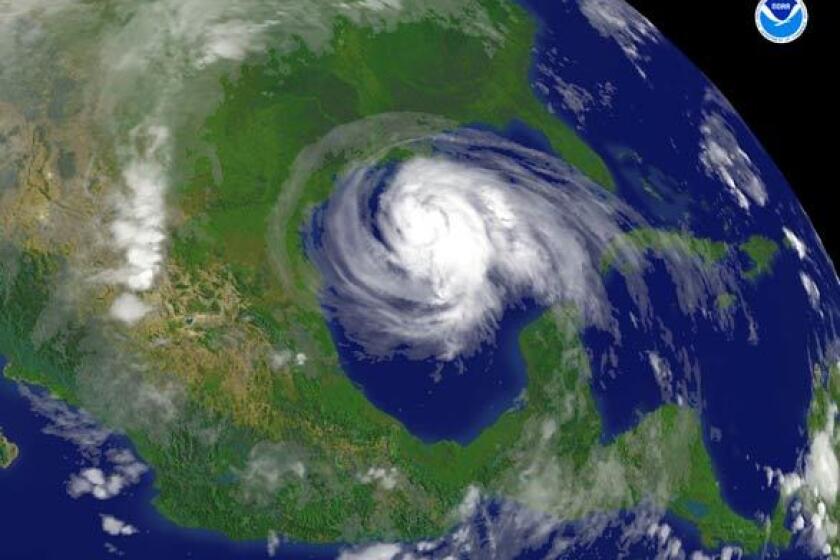Hurricane Iota makes landfall on Nicaragua coast

- Share via
MANAGUA, Nicaragua — Hurricane Iota made landfall on Nicaragua’s Caribbean coast late Monday, threatening catastrophic damage to the same part of Central America already battered by equally strong Hurricane Eta less than two weeks ago.
Iota had intensified into an extremely dangerous Category 5 storm early in the day, but the U.S. National Hurricane Center said it weakened slightly to Category 4, with maximum sustained winds of 155 mph. Its center made landfall about 30 miles south of the Nicaraguan city of Puerto Cabezas, also known as Bilwi.
On Tuesday morning, Iota still carried hurricane force winds as a Category 1 storm, moving inland over northern Nicaragua with maximum sustained winds of 85 mph. It was 15 miles west-northwest of El Pia, moving westward at 9 mph. The storm was forecast to cross southern Honduras late Tuesday.
In Bilwi, business owner Adán Artola Schultz braced himself in the doorway of his house as strong gusts of wind and rain drove water in torrents down the street. He watched in amazement as wind ripped away the metal roof structure from a substantial two-story home and blew it away like paper.
“It is like bullets,” he said of the sound of metal structures banging and buckling in the wind. “This is double destruction,” he said, referring to the damage wrought by Eta just 12 days earlier.
“This is coming in with fury,” Artola Schultz said.
Storm surge was on the mind of Yasmina Wriedt on Monday in Bilwi’s El Muelle neighborhood, tight against the sea.
“The situation doesn’t look good at all,” Wriedt said. “We woke up without electricity, with rain, and the surf is getting really high.”
Wriedt, who works for the small-scale fishing organization Piquinera, said the roof of her house was blown off in Eta.
“We repaired it as best we could; now I think the wind will take it again, because they say [Iota] is even stronger,” Wriedt said, the sound of hammering echoing around her as neighbors boarded windows and reinforced roofs.
During Eta, the surf came up to just behind her house, where she lives with eight members of her family.
“Today I’m afraid again about losing my house,” she said, “and I’m frightened for all of us who live in this neighborhood.”
Wriedt said some neighbors had left the area, but most have stayed. “We’re almost all here,” she said. “Neither the army nor the government came to move us.”
Cairo Jarquin, Nicaragua emergency response project manager for Catholic Relief Services, visited Bilwi and smaller coastal communities Friday.
It used to be that Atlantic hurricanes would lose most of their strength within a day of making landfall. Due to climate change, that’s no longer true.
In Wawa Bar, Jarquin said, he found “total destruction” from Eta. People had been working furiously to put roofs back over their families’ heads, but Iota threatened to take what was left.
“The little that remained standing could be razed,” Jarquin said. There were other communities farther inland that he was not able to reach due to the condition of the roads. He said he heard that Wawa Bar was evacuated again Saturday.
Evacuations were being conducted from low-lying areas in Nicaragua and Honduras near their shared border through the weekend.
Nicaraguan Vice President Rosario Murillo, who is also the first lady, said Monday that the government had done everything necessary to protect lives, including evacuating thousands. She added that Taiwan had donated 800 tons of rice to help those affected by the storms.
Limborth Bucardo, who rode out Eta with his wife and two children at home, this time decided to move in with relatives in a safer neighborhood. He said many people had moved into churches in Bilwi.
“We hadn’t finished repairing our houses and settling in when another hurricane comes,” Bucardo said. “The shelters in Bilwi are already full, packed with people from [surrounding] communities.”
Iota is the record 30th named storm of this year’s extraordinarily busy Atlantic hurricane season. It’s also the ninth storm to rapidly intensify this season, a dangerous phenomenon that is happening more often. Such activity has focused attention on climate change, which scientists say is causing wetter, stronger and more destructive storms.
As a ferocious hurricane bears down on South Florida, water managers desperately lower canals in anticipation of 4 feet of rain.
In Honduras, compulsory evacuations began before the weekend. In the northern region alone, 63,500 people were reported to be in 379 shelters by Sunday evening, while the whole country was on high alert.
Nicaraguan officials said that by late Sunday afternoon about 1,500 people, nearly half of them children, had been evacuated from low-lying areas in the country’s northeast, including all the inhabitants of Cayos Miskitos. Authorities said 83,000 people in that region were in danger.
Eta hit Nicaragua as a Category 4 hurricane, killing at least 120 people as torrential rains caused flash floods and mudslides in parts of Central America and Mexico. Then it meandered across Cuba, the Florida Keys and around the Gulf of Mexico before slogging ashore again near Cedar Key, Fla., and dashing across Florida and the Carolinas. Eta was the 28th named storm of this year’s hurricane season, tying the 2005 record. The 29th, Theta, was far out in the eastern Atlantic Ocean on Sunday and had become a remnant low.
Iota was forecast to drop 8 to 16 inches of rain in northern Nicaragua, Honduras, Guatemala and southern Belize, with as much as 30 inches in isolated spots. Costa Rica and Panama could also experience heavy rain and flooding, the hurricane center said.
Iota is stronger, based on central pressure, than 2005’s Hurricane Katrina and is the first storm with a Greek alphabet name to hit Category 5, Colorado State University hurricane researcher Phil Klotzbach said. No Category 5 hurricane has ever come this late in the season; Iota beats the record set by the Cuba Hurricane, which arrived Nov. 8, 1932.
Meteorologists have become concerned over the last couple of decades about storms like Iota that power up much faster than usual. They created an official threshold for rapid intensification: a storm gaining 35 mph in wind speed in just 24 hours. Iota doubled this threshold.
The prospect of more rain was raising the anxiety of those still homeless after Eta.
On Monday, Carmen Isabel Rodríguez Ortez, 48, was still living inside a government shelter with more than 250 people in La Lima, Honduras, just outside San Pedro Sula. Devastated by Eta’s destruction, she quickly broke into sobs as she contemplated another storm.
“We’re living a real nightmare,” Rodríguez said. The Chamelecón River flooded her Reformada neighborhood as Eta passed, submerging homes. “Now they announce more rain, and we don’t know what’s going to happen, because our homes are completely flooded,” she said.
The official end of hurricane season is Nov. 30.
More to Read
Sign up for Essential California
The most important California stories and recommendations in your inbox every morning.
You may occasionally receive promotional content from the Los Angeles Times.











